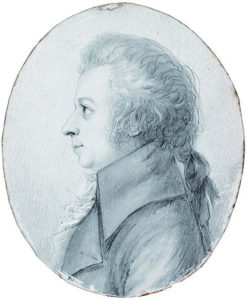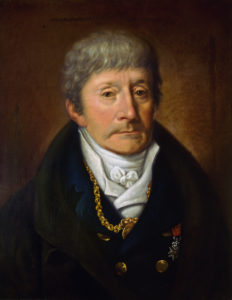
We mark the completion, on August 10, 1788 – 232 years ago today – of Mozart’s Symphony in C major, catalogued by Ludwig Köchel as K. 551 and nicknamed the “Jupiter”. It was Mozart’s final symphony, a towering, innovative masterwork, the greatest symphony ever composed to its time and by any standard of measure one of a handful of greatest symphonies ever composed. That it took Mozart all of 16 days to commit it to paper defies our imaginations. That it was composed back-to-back with the luminous, transcendentally lyric Symphony in E-flat major and the tragic, gut-busting Symphony in G Minor in something under a total of eight weeks beggars our belief. Finally, that Mozart managed this mind-blowing compositional feat while under a black cloud of grief, physical ill-health, and mounting financial disaster is just, well, inconceivable.
Let’s add a bit more head-shaking information to the mix. At the same time he was composing these last three symphonies, Mozart was composing a number of other works as well! He completed his Trio for piano, violin and cello in E Major, K. 542 on June 22, 1788 and the Trio in C Major, K. 548, on July 14; he finished his famous “easy” Piano Sonata in C major, K. 545 on June 26; and the Sonata for piano and violin in F major K. 547 was inscribed as having been completed on July 10.
We cannot fathom how he managed all of this, and we’re not even going to try. Let us, instead, set the stage for the summer of 1788.
Money
By the summer of 1788, Mozart’s finances were beginning to spiral out of control. The numbers tell the story: in 1786, despite the success of The Marriage of Figaro, Mozart earned 30% less than he had in 1784. By 1788, his income had plummeted a further 35%, to the lowest level since 1781, the year he moved to Vienna. There are a number of reasons behind this precipitous falloff in income. First and most importantly, the 34-year-old Mozart’s popularity in Vienna was drying up: commissions, subscriptions, performance opportunities, and publications were simply not coming in. How can this possibly be, we ask incredulously: Mozart was approaching his prime, writing music the likes of which no one had ever heard before, plumbing new levels of expression and compositional unity in music of unprecedented complexity.
Exactly.
It’s a fact: Mozart the composer had evolved past his essential Viennese audience, and was unwilling – indeed, most likely incapable – of dialing it back in order to appeal to a larger audience. By 1788, much of that Viennese audience, an audience that had so embraced him back in 1781, had come to consider him a composer of difficult new music. It didn’t help, either, that for all of its success back in 1786, Mozart’s opera The Marriage of Figaro was increasingly perceived as having bitten the aristocratic hand that fed him.
The political situation in Vienna was also partly to blame for Mozart’s financial decline. On February 9, 1788, Emperor Joseph II dragged the Austrian Empire into what turned out to be a costly and exceedingly unpopular war with the Ottoman Turks, a war that would cost Joseph his life in 1790 and which wouldn’t end until 1791. Failure to win a decisive, early victory necessitated huge war expenditures, which along with a series of bad harvests and inflation, threatened the Austrian population – from the aristocracy on down – with destitution. Degrees in macroeconomics are not necessary to realize that under such depressing circumstances, the rich were not going to indulge in luxuries, which sucked the blood out of Vienna’s cultural life like a lamprey latched onto a bass.
The theaters were particularly vulnerable to cutbacks. The German opera theater was disbanded in late February of 1788. Most of the full-time performers at the Italian Opera theater were given notice in August 1788. Concert activity declined precipitously, and those good people that had the money to leave Vienna did so, fearing conscription.
Back to Mozart. Is it necessary to point out that it will be difficult for a musician to make a living if the theaters and concert halls are closed and the aristocracy has left town?
Mozart and his wife Constanze tried to cope; they cut costs where they could. But it was too little too late – they’d lived too high for too long – and their financial bubble burst.
In June of 1788, Mozart wrote the first of a series of increasingly desperate letters to his friend and Masonic brother, Michael Puchberg, begging for money. In one of those letters, undated but presumed by the musicologist H. C. Robbins Landon to have been written in August of 1788, Mozart wrote:
“I implore you to help me out with 100 florins until next week, when my concerts at the Casino begin. By then, my subscription money must necessarily have come in, and I can then quite easily repay you with warmest thanks.”
There is no indication that any such concerts took place. In the past, Mozart had self-produced concerts, like those he was apparently planning for Philip Otto’s spanking-new “Casino” on Vienna’s Spiegelgasse, during which he performed newly composed works for a subscription audience. It is believed that the letter to Puchberg indicates that his final three symphonies were composed for just such a series of subscription concerts that, because of his waning popularity, never actually occurred.

(For our information: for many years, it was believed that Mozart never heard any of his final three symphonies before he died on December 5, 1791. But that’s actually not true. On April 16 and 17, 1791, Court Kapellmeister Antonio Salieri himself conducted the annual Lenten concerts of the Tonkünstler-Societät, the “Society of Musicians”, a benevolent society for musicians founded in 1772. The first piece on the concerts was “Eine neue grosse Simphonie von Herrn Mozart”, “a new, big symphony by Mr. Mozart.” The question: which of Mozart’s “new” symphonies was performed? Based on the instrumentation available, that symphony was almost certainly the G Minor, K. 550.)
In April of 1787, the downturn in Mozart’s finances forced his family to move from their expensive digs in the inner city to a smaller, less expensive flat on the outskirts of the city at Landstrasse 224. It was there that the fourth of Wolfgang and Constanze’s six children was born – a daughter named Theresia – on December 27, 1787. And it was there that the poor child died six months later, on June 29, 1788, while her father was working on his Symphony in G Minor. The horrific child mortality of the time notwithstanding, there’s nothing that can prepare a parent for the death of a child, and the Mozarts were devastated.
Mozart, who was prone to depressive episodes, entered one. His physical health, which was never very good (not that anyone’s was in those days), followed suit, and he was plagued by a series of nasty respiratory infections during that hot, humid, unhappy summer.
(The New York Times music critic Donal Henahan had this to say about Mozart’s health:
“From childhood on, Mozart suffered from a series of diseases that should have sucked all the creative energy from him. Letters and other documents describe upper respiratory tract infections, body lesions, tonsillitis, severe toxemia, delirium, skin rash, pneumonia, typhoid fever, rheumatism, rheumatic fever, smallpox (his face was permanently disfigured by the disease), dental abscesses, bronchitis, yellow jaundice, catarrh, pains in the eyes and ears, viral infection, and much else. Seldom, it would seem, was he in even moderately good health.
Mere day-to-day existence must have been difficult under the burden of such painful illnesses. What could such a sick man accomplish?”
What could such a sick man accomplish? How about those three final symphonies during the awful summer of 1788, capped with the completion of the magisterial Jupiter, which he inscribed as having completed 232 years ago today. Join me tomorrow on Patreon for my Dr. Bob Prescribes post, which will delve into the Jupiter Symphony in some detail.
Listen on the Music History Monday Podcast
Podcast: Play in new window
Subscribe: Apple Podcasts | Spotify | Pandora | iHeartRadio | RSS | More
